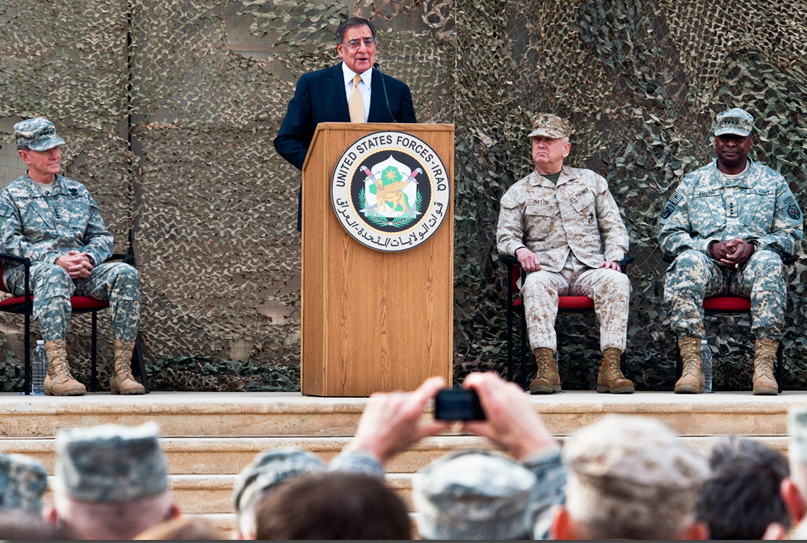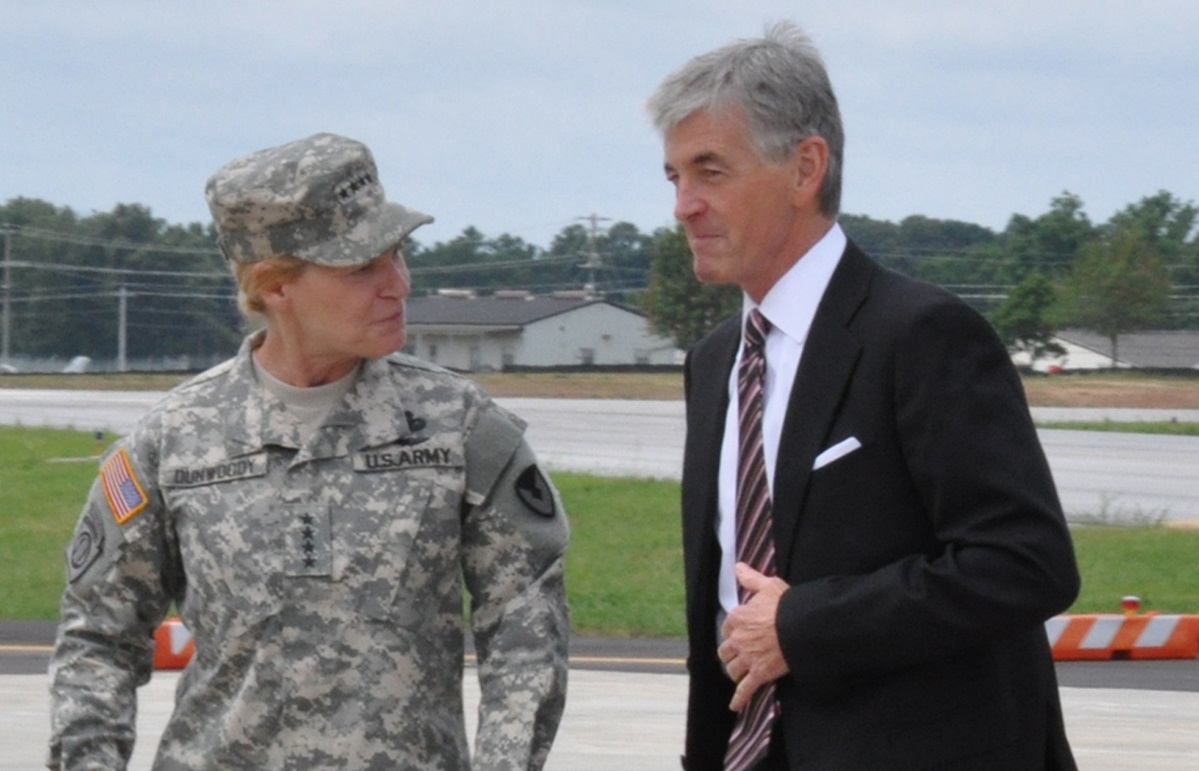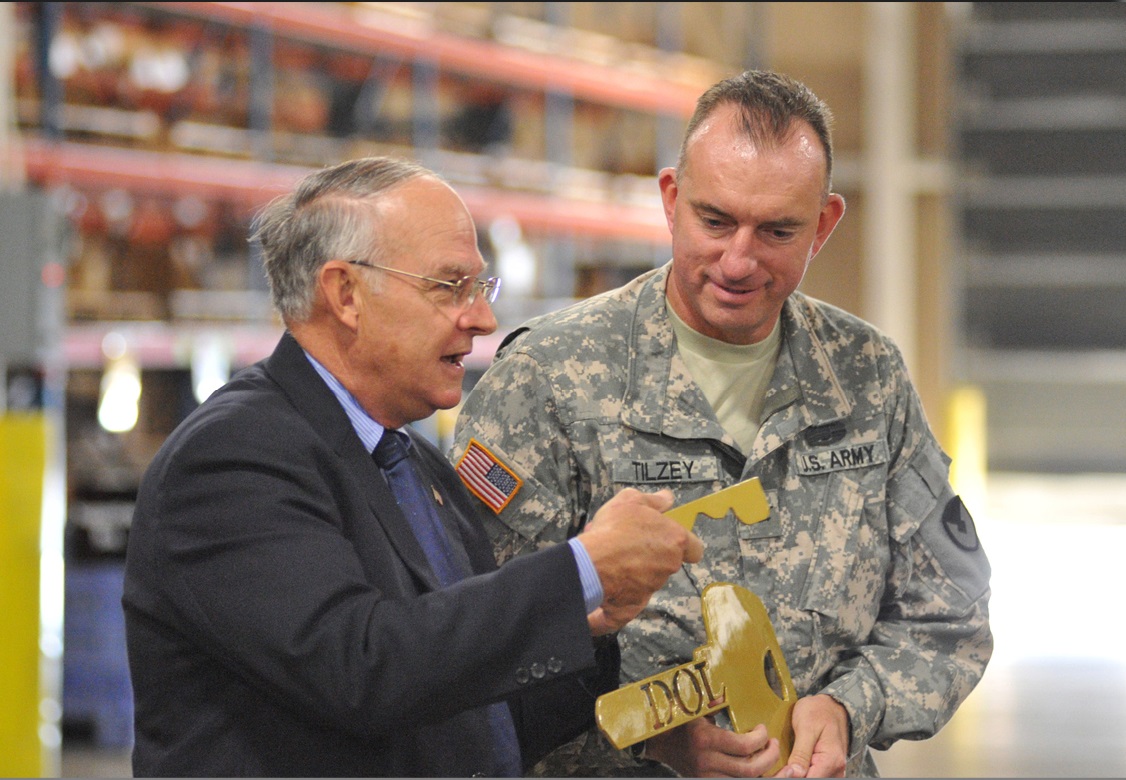The 21st Century — 2001-Today
In the fifth decade of its history, AMC's greatest accomplishment was the ability to support joint warfighters on two fronts – Iraq and Afghanistan, regardless of its many other demands. AMC supported that effort while also sustaining contingency operations in places like Haiti, Pakistan, and Japan, and while completing the largest consolidation under the Base Realignment and Closure (BRAC) Commission's recommendations in history. At the same time, AMC continued the reset of the Army's and its joint partner's equipment after a decade at war to regenerate combat power for future deployments. This meant operating AMC's depots, arsenals, and plants at three times the rate AMC ran them at the height of the Vietnam War.
September 11, 2001

The terrorist attacks of Sept. 11, 2001, and the American response generated challenges to the military logistics community both at home and overseas. As the U.S. and its coalition partners launched Operation Enduring Freedom (OEF) to destroy terrorist training camps and infrastructure and the Taliban military in Afghanistan and as the coalition partners began planning for possible war with Iraq, senior logistics leaders infused their organizations with a sense of urgency to meet the changed environment.
Without delay, AMC mobilized to assist first responders, to secure valuable assets, and to support Soldiers deployed around the globe. AMC re-emphasized its determination to push forward, to put AMC Soldiers, civilians, and contractors on the line with the warfighters. It also redoubled efforts to improve logistics and manufacturing processes in order to provide enhanced equipment in a timelier manner. Overall, the command focused its energy on making the slogan a reality – "get the right supplies to the right place at the right time for the joint force."
Early OEF/OIF Efforts

From the beginning, members of the logistics community responded, providing people, equipment, and supplies to New York City and to the Pentagon and establishing base camps in Uzbekistan to support Coalition forces in Afghanistan. They played a major role in preparing for Operation Iraqi Freedom (OIF). AMC's Logistics Support Element – Southwest Asia (LSE-SWA) managed the download, build-up, issues of pre-positioned equipment, and its push on Baghdad.
The AMC force grew to more than 8,500 by May 2003. In terms of prepositioned equipment, AMC provided stocks from ships, including 6.4 million MREs (meals ready to eat) and 58,000 tons of ammunition. Prepositioned stocks on land included another 8 thousand tons of ammunition as well as 324 tanks, 374 Bradley Fighting Vehicles, 9,426 HMMWVs, and 7,074 other trucks.
During the summer of 2003, Logistics Assistance Representatives (LARs) found ways to deal with significant shortages in tank track, Bradley track shoes, and aviation parts by improving distribution in theater and ramping up production back home. During the spring and summer of 2004, with the rise of insurgent attacks, logisticians continued to provide support while dealing with the increased threats to the long supply lines from Kuwait into Iraq. Meanwhile, the U.S. Army Combined Arms Support Command sent teams into theater to assist soldiers in addressing problems; for example, sending Automated Logistics Assistance Teams to help soldiers order and track parts requisitions.
AMC implemented a number of organizational changes and achieved several milestones in moving towards networking logisticians and warfighters via digital capabilities. The entire Army was converted and capitalized under the Single Stock Fund by May 2003, the Logistics Modernization Program went "live" in July 2003, and AMC continued its push to "deliver seamless logistics business processes and seamless automation from factory to foxhole."
At the same time, AMC sought funding and pursued innovative partnerships to rejuvenate its industrial base of arsenals, maintenance depots, and ammunition plants. Moreover, it implemented programs intended to improve productivity and managerial efficiencies in the industrial operations, using the Lean Six Sigma methodology to evaluate and improve processes. The Command claimed a number of successes, including improved processes for rebuilding helicopter engines and for recapitalizing HMMWVs. The improvements saved time and produced better equipment and also saved money. Overall, AMC saved in excess of $100 million in 2005 by applying Lean Six Sigma.
Responsible Reset Task Force

Prior to December 2011, AMC and its strategic partners' focus was the retrograde of equipment from the Afghanistan and Iraqi theaters of operations in support of OEF, OIF, and Operation New Dawn (OND). AMC established a footprint in theater during OIF supporting Combined Joint Task Force (CJTF)-7 with a LSE Iraq in May 2003, along with seven subordinate commands which eventually transitioned into the 402nd AFSB in October 2006.
Responsible Reset Task Force (R2TF) was established in August 2009 to facilitate information and decisions to meet requirements and deadlines while meeting reset requirements for the force. R2TF brought to the forefront in theater, a unique blend of strategic, operational, and functional skill sets that provided logistics, transportation, modeling, simulation, and operation research capabilities allowing for enhanced planning and retrograde mission execution. In other words, R2TF served as a large 'catcher's mitt' in Kuwait for all the equipment coming out of Iraq to ensure AMC could not only track it, but return it, repair it, dispose of it, or redistribute it.
Because AMC was forward deployed, it was able to support efforts to ship equipment directly from Iraq to Afghanistan. More than 50 percent of the equipment needed for the Afghan surge came from equipment coming out of Iraq – a large cost avoidance. Management of equipment on this magnitude would not have been possible in the past because the automation tools did not exist. However, because of advancements in automated systems and forward deployed logistics capabilities, AMC was able to see the equipment and, as a result, could repair the equipment in theater and ship the equipment straight to Afghanistan instead of shipping from the United States. R2TF's mission was fully integrated with the U.S. Central Command (CENTCOM) and the U.S. Army Central (ARCENT) in theater. In a March 2012 interview, Gen. Ann E. Dunwoody, commanding general of AMC, stated "What I'm most proud of is how today's AMC really does serve as an extension of the CENTCOM and ARCENT families and is a full member of that great, joint logistics team."
If one could put all the equipment that was in Iraq in a single convoy, it would stretch over 2,000 miles. Throughout the course of OIF/OND, AMC deployed, sustained, and redeployed 314 brigade-equivalent units. It retrograded more than 2.4 million pieces of equipment. The troop movement to Kuwait was akin to evacuating the entire population of Quincy, Massachusetts, and moving it to Washington, D.C. If AMC stacked every container that left Iraq, the stack would be 51 miles high – nine times the height of Mt. Everest. This was a logistics mission on a historic scale.
End of Operation New Dawn

On Dec. 15, 2011, Defense Secretary Leon E. Panetta joined Chairman of the Joint Chiefs of Staff General Martin E. Dempsey and other U.S. and Iraq leaders in honoring eight years of service and sacrifice as they commemorated the end of the U.S. military mission in Iraq.
Institutional Adaptation
Institutional adaptation has been critical in AMC's success. Throughout this period, AMC worked to link the industrial base to the operational force and focused on supporting the Joint Force and the Combatant Commanders. Since 9/11, AMC built a number of new capabilities for the joint soldier.
Army Field Support Brigades
AMC's AFSBs, Army Contracting Brigades, and Transportation Brigades were aligned with each of the Combatant Commands in order to respond to the needs of the joint warfighter across the logistics spectrum.
AMC Designated Army's Lead Materiel Integrator

At the same time AMC was adapting its operational arm, it worked to alter its generating arm in order to better synchronize the distribution and redistribution of equipment. On 22 March 2011, the Secretary of the Army designated AMC as the Army's Lead Materiel Integrator (LMI). The LMI approach to materiel management will be transformational model for the Army and changed how the Army will equip the warfighter.
On Feb. 15, 2012, AMC formally assumed the LMI mission for the Army. LMI synchronized the distribution and redistribution of Army materiel, in relation to priorities and directives. ASC, LMI's executing agent, serves as the Army's single synchronization point, working with all stakeholders to source Army materiel requirements. Through use of the Distribution Management Center, AFSBs, and Directorates of Logistics, ASC ensures that the right material will be provided in the right quantity and condition and delivered to the right place, at the right time.
The LMI mission will be an ongoing process that will continuously improve the efficiency and effectiveness of Army materiel management. The end state of the LMI approach would be fully integrated and synchronized materiel distribution and redistribution process at best value for the Army.
For the first time, LMI will integrate equipment that is on hand with maintenance availability. This will also leverage state-of-the-art automation to establish one authority, one source of repair and one information system, all working together to provide visibility of every piece of equipment across the Army.
Contracting

In 2007, the Secretary of the Army formed an independent commission on Army Acquisition and Program Management in Expeditionary Operations, also known as the Gansler Commission, to review recent lessons learned and recommend ways to improve future military operations. In compliance with these recommendations, on Oct. 1, 2008, the Army recognized the formal establishment of the Army Contracting Command (ACC) as a major subordinate command of AMC. This one-of-a-kind Army organization would perform the majority of contracting work for the U.S. Army, and consisted of two subordinate commands responsible for installation and expeditionary contracting, and other Army contracting elements.
Gen. Dunwoody said it best when she stated in an AUSA interview "We cannot underestimate contracting as a combat multiplier or 'weapon system' on the battlefield." Contracting allowed AMC to support programs that hired the local Iraqi and Afghanistan population and gave them jobs while infusing money into their economy. AMC considered this as a powerful tool for nation-building. It also helped enable combatant and field Commanders' theater engagement and partnering strategies.
ACC maintains contracting support brigades that are able to deploy forward with trained and certified contract managers that can give oversight to the contracting business in theater. AMC hired and trained more than 900 new acquisition professionals to meet growing demand for contract operations. In addition, AMC implemented initiatives such as Service Contract Reform, a tool that incorporated better buying power and optimization of services contracts across the Army. In fact, AMC was the only service that had a command and control capability associated with its contracting capability.
Military Surface Deployment and Distribution Command
Another organization adaptation was the realignment of U.S. Army Military Surface Deployment and Distribution Command (SDDC) to AMC with operational control to AMC's joint partners at the Transportation Systems Command. With SDDC's assignment to AMC on Jan. 16, 2007, AMC was able to control and coordinate the movement of equipment, supplies and services.
The benefit of this is that AMC has been able to connect what was historically the industrial, CONUS-based organization to the joint warfighter – factory to foxhole, concept to combat.
Directorate of Logistics Enterprise Transformation

The DOL Enterprise Transformation was an Army initiative to align all Army functions within four Army Enterprises: Human Capital, Readiness, Materiel, and Support Services. Aligning the DOL Materiel support functions into the Materiel Enterprise aligned functions to the core competencies of the enterprise and into a single command and control structure. This alignment of ammunition supply, retail supply support, central issue facilities, asset management, materiel support maintenance, transportation, and other installation support services would enable AMC to streamline support and to execute efficiencies and changes quicker. The magnitude of the transfer would cover 74 DOLs worldwide.
AMC and the Installation Management Command (IMCOM) signed a Memorandum of Agreement on Jan. 23, 2007, to begin this process. By Oct. 1, 2012, transfer of DOL personnel and resources worldwide from IMCOM to AMC is expected to be completed. This would include the transfer of 73 installations worldwide, $700 million in assets, and over 5,400 DA Civilians and over 18,000 contractors by IMCOM to AMC. Current potential cost savings/avoidance is estimated to be over $40 million.
The transfer will enable AMC to eliminate redundancies in logistics contracts and reduce contract management costs, eliminate redundant installation maintenance support programs, and reduce costs in management and maintenance of left behind equipment. The end state would link installation logistics to AMC's technical, industrial, and logistical base, thus maximizing the utilization of the Army's logistics capacity and capabilities.
Base Realignment and Closure

In the fall of 2002, plans were approved to relocate Headquarters, AMC, to Fort Belvoir, Virginia. One of the main reasons for this move was that location on an Army installation in the post-9/11 environment would provide enhanced security from a force protection standpoint. Also, staying in the 30-year old building on Eisenhower Avenue would probably require an extensive rehabilitation effort to provide full information technology capabilities. A ceremony to celebrate the command's arrival at Fort Belvoir was held in March 2003.
In 2005, BRAC recommended to Congress the movement of AMC Headquarters from Fort Belvoir to Redstone Arsenal, Alabama. The Redstone move was completed in two phases – the first into temporary locations at Redstone and then into a permanent facility once it was completed. A groundbreaking ceremony was held at Redstone Arsenal on Sept. 17, 2008, for two buildings with a common lobby that would house both AMC and U.S. Army Security Assistance Command (USASAC).
On June 15, 2011, Dunwoody conducted a "touchdown" ceremony in front of the new AMC Headquarters Building (Building 4400). The ceremony marked the completion of AMC's move from Ft. Belvoir, Virginia, to Redstone Arsenal, Alabama. For the first time in AMC history the Army had an integrated operations center providing near real-time visibility of the materiel and services our warfighters need.
Throughout the command, BRAC affected 11,000 AMC employees – one out of every six – across 25 states. It was the largest BRAC round in the history of the Army. This action also closed four ammo plants (Lonestar, Riverbank, Mississippi, and Kansas) and transitioned those bases to IMCOM as their core competency. It also:
- Eliminated excess depot maintenance capacity at Red River and Rock Island
- Relocated 85,000 tons of ammo
- Eliminated 1,274 jobs while obtaining above forecast volunteer relocations (AMC Headquarters 56 percent; TACOM 45 percent; CECOM 64 percent)
BRAC also allowed AMC to take advantage of synergies in its organizations as AMC shifted its centers of gravity to four locations: Redstone Arsenal, Aberdeen Proving Ground, Maryland, Warren, Michigan, and Rock Island Arsenal, Illinois. At Redstone Arsenal, AMC is co-located on the installation with USASAC, ACC, the Expeditionary Contracting Command, U.S. Army Aviation and Missile Command, and AMC's Logistics Support Agency.
Looking to the Future
The complex process of providing materiel and logistics support to the warfighter will continue on as it has since AMC first began operations more than 50 years ago. AMC sustains the Army by providing America's warfighters with the decisive edge.
“The world is changing. The friendly force is changing. The enemy is changing. We have to change,” said Gen. Gus Perna, the current AMC commanding general. “We have to change to ensure our output is not process-oriented, but about what is best for the battlefield.”